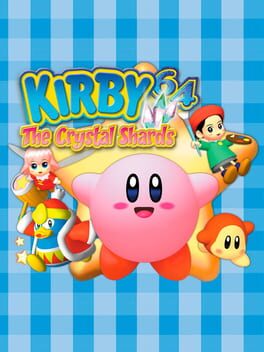The shift from 2D to 3D games was the biggest change the video games industry has ever seen (and possibly will ever see). Decades of established design needed to be rethought. It's not surprising this era brought with it major changes to the players in the industry: The birth of Sony and the death of Sega can at least partially be attributed to the PS1's strong lineup of early 3D classics, and Sega's haphazard translation of Sonic to 3D.
The point is, a huge part of why Nintendo maintained their presence in the industry is because of just how good Nintendo's early 3D titles were. Super Mario 64 and Ocarina of Time are more than just great games--they are so good, they made the transition to 3D look effortless.
This is why Kirby 64 is so fascinating. Kirby 64 is the only example of Nintendo seriously dropping the ball on the shift to 3D. Kirby 64 is more than just a mediocre game for the Nintendo 64. It gives us a view into an alternate timeline, one where Nintendo fumbled the transition to 3D games, and maybe even went the way of Sega.
It's especially surprising Kirby 64 is such a flop because... well... the game is hardly 3D. Kirby 64 is a 2.5D platformer. The game is rendered in full 3D, but the player's movement is restricted to a 2D axis. This ends up being the worst of both worlds. Kirby 64 gains almost nothing by presenting the player a 3D view. But, since rendering 3D environments is so graphically intensive, the dense levels of Kirby Superstar are not technically possible. The result is that Kirby 64's levels are barren wastelands compared to older Kirby games.
The combo transformations are actually a great concept. Kirby 64 has 35 different copy abilities, still the largest pool of any Kirby game to date. These are really fun to discover and experiment with: the resulting combination is always surprising, yet still makes perfect sense considering the reagents. Spark + Ice turning Kirby into a fridge is particularly memorable. Honestly, its amazing the execution of this concept is so strong, considering the rest of the game is such a slog.
This said, the level design seriously drops the ball on this concept. A great example of emergent design is the lightbulb power (bomb + spark) which can light up dark rooms. This is how Kirby 64's puzzles should have worked. Instead, most of the actual use of these copy abilities stems from colored blocks that require specific abilities to break. Not only is this a glorified lock-and-key, but it is completely impossible to know what power will be needed until the player reaches the block and it is already too late. This means that, if you want to actually collect the titular Crystal Shards, you're forced to play every stage twice. The stages usually aren't even fun the first time.
Anyway, Kirby 64 isn't all bad, but it seems to misunderstand what makes a 3D game great, and what makes a Kirby game great. In short, Kirby 64 isn't a horrible game, but it is no surprise Nintendo would wait another 20 odd years before attempting another 3D Kirby.
The point is, a huge part of why Nintendo maintained their presence in the industry is because of just how good Nintendo's early 3D titles were. Super Mario 64 and Ocarina of Time are more than just great games--they are so good, they made the transition to 3D look effortless.
This is why Kirby 64 is so fascinating. Kirby 64 is the only example of Nintendo seriously dropping the ball on the shift to 3D. Kirby 64 is more than just a mediocre game for the Nintendo 64. It gives us a view into an alternate timeline, one where Nintendo fumbled the transition to 3D games, and maybe even went the way of Sega.
It's especially surprising Kirby 64 is such a flop because... well... the game is hardly 3D. Kirby 64 is a 2.5D platformer. The game is rendered in full 3D, but the player's movement is restricted to a 2D axis. This ends up being the worst of both worlds. Kirby 64 gains almost nothing by presenting the player a 3D view. But, since rendering 3D environments is so graphically intensive, the dense levels of Kirby Superstar are not technically possible. The result is that Kirby 64's levels are barren wastelands compared to older Kirby games.
The combo transformations are actually a great concept. Kirby 64 has 35 different copy abilities, still the largest pool of any Kirby game to date. These are really fun to discover and experiment with: the resulting combination is always surprising, yet still makes perfect sense considering the reagents. Spark + Ice turning Kirby into a fridge is particularly memorable. Honestly, its amazing the execution of this concept is so strong, considering the rest of the game is such a slog.
This said, the level design seriously drops the ball on this concept. A great example of emergent design is the lightbulb power (bomb + spark) which can light up dark rooms. This is how Kirby 64's puzzles should have worked. Instead, most of the actual use of these copy abilities stems from colored blocks that require specific abilities to break. Not only is this a glorified lock-and-key, but it is completely impossible to know what power will be needed until the player reaches the block and it is already too late. This means that, if you want to actually collect the titular Crystal Shards, you're forced to play every stage twice. The stages usually aren't even fun the first time.
Anyway, Kirby 64 isn't all bad, but it seems to misunderstand what makes a 3D game great, and what makes a Kirby game great. In short, Kirby 64 isn't a horrible game, but it is no surprise Nintendo would wait another 20 odd years before attempting another 3D Kirby.
